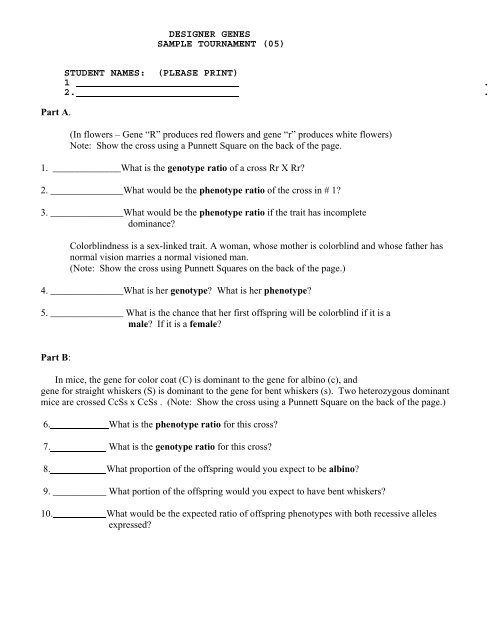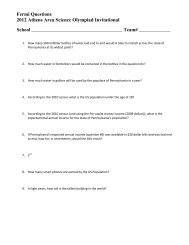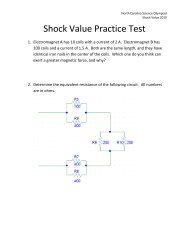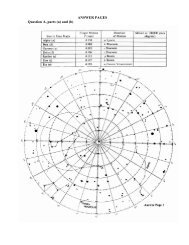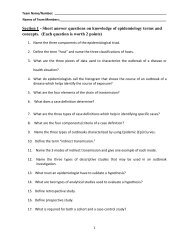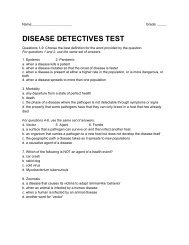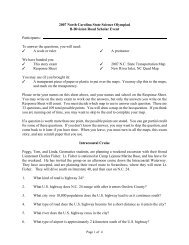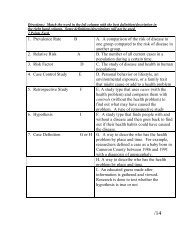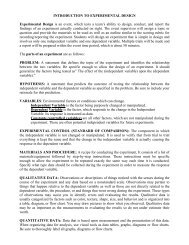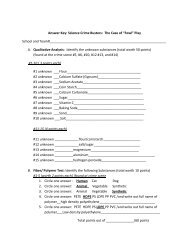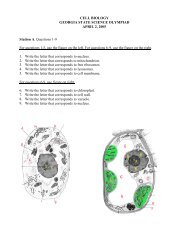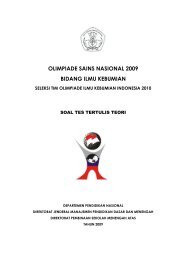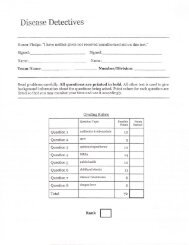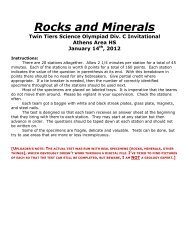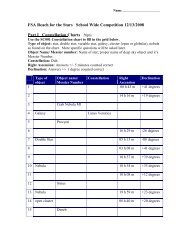DESIGNER GENES SAMPLE TOURNAMENT (05) STUDENT ...
DESIGNER GENES SAMPLE TOURNAMENT (05) STUDENT ...
DESIGNER GENES SAMPLE TOURNAMENT (05) STUDENT ...
Create successful ePaper yourself
Turn your PDF publications into a flip-book with our unique Google optimized e-Paper software.
<strong>DESIGNER</strong> <strong>GENES</strong><br />
<strong>SAMPLE</strong> <strong>TOURNAMENT</strong> (<strong>05</strong>)<br />
Part A.<br />
<strong>STUDENT</strong> NAMES: (PLEASE PRINT)<br />
1 .<br />
2. .<br />
(In flowers – Gene “R” produces red flowers and gene “r” produces white flowers)<br />
Note: Show the cross using a Punnett Square on the back of the page.<br />
1. ______________What is the genotype ratio of a cross Rr X Rr?<br />
2. _______________What would be the phenotype ratio of the cross in # 1?<br />
3. _______________What would be the phenotype ratio if the trait has incomplete<br />
dominance?<br />
Colorblindness is a sex-linked trait. A woman, whose mother is colorblind and whose father has<br />
normal vision marries a normal visioned man.<br />
(Note: Show the cross using Punnett Squares on the back of the page.)<br />
4. _______________What is her genotype? What is her phenotype?<br />
5. _______________ What is the chance that her first offspring will be colorblind if it is a<br />
male? If it is a female?<br />
Part B:<br />
In mice, the gene for color coat (C) is dominant to the gene for albino (c), and<br />
gene for straight whiskers (S) is dominant to the gene for bent whiskers (s). Two heterozygous dominant<br />
mice are crossed CcSs x CcSs . (Note: Show the cross using a Punnett Square on the back of the page.)<br />
6. What is the phenotype ratio for this cross?<br />
7. What is the genotype ratio for this cross?<br />
8. What proportion of the offspring would you expect to be albino?<br />
9. ___________ What portion of the offspring would you expect to have bent whiskers?<br />
10. What would be the expected ratio of offspring phenotypes with both recessive alleles<br />
expressed?
Part C<br />
Examine the pedigree and answer the following questions.<br />
What is the relationship of the following individuals?<br />
11. # 1 and # 4<br />
12. # 11 and # 12<br />
Give the possible genotypes and then the blood type for the following individuals.<br />
13. Individual # 2<br />
14. Individual # 3<br />
15. Individual # 8<br />
Part D. Examine the provided karyotypes and answer the following questions.<br />
Individual A<br />
Individual B<br />
16. What is the sex of individual A?<br />
17. What is the sex of individual B?<br />
18. What defect does individual A have?<br />
19. What defect does individual B have?<br />
20. How many chromosomes are in a normal somatic (body)<br />
cell of individual A?
Part E. Examine the data provided and answer the following questions.<br />
For question 21, Your are given the following gene to gene distances<br />
B-C<br />
D-C<br />
A-B<br />
D-A<br />
3 map units<br />
7 map units<br />
8 map units<br />
12 map units<br />
21.___________________________________________________ Draw a complete map that includes all<br />
genes and the distances between the genes.<br />
For Question 22, consider the cross:<br />
AaBbCc x AaBbCc<br />
22.______________ How many different kinds of gametes can each parent produce?<br />
Show the combinations for each parent below:<br />
For question 23, Albinism is an absence of pigment. Two normal adults marry and have a child<br />
that is an albino.<br />
23.______________ Is albinism dominant or recessive? What is the probability that the next child<br />
will be an albino?<br />
For question 24, in humans, 1 in 10,000 females have a rare sex-linked recessive genetic disorder.<br />
24 ______________What is the frequency of the affected males?<br />
For question 25, a small fragment of DNA has been collected at a crime scene.<br />
25.______________ What is the name of the procedure in DNA analysis which allow one to<br />
make many copies of a piece of DNA?
Part F:<br />
Examine the information concerning the paternal case. Use the evidence from the blood samples<br />
and DNA analysis to answer the questions.<br />
Blood Analysis<br />
PARENTAL CASE<br />
DNA ANALYSIS KEY<br />
Mother I A i #1-Sample from mother's blood<br />
Child i i #2-Sample from child's blood<br />
Possible Father<br />
#1<br />
Possible Father<br />
#2<br />
Possible Father<br />
#3<br />
I A B<br />
I<br />
#3-Sample from possible father<br />
#1<br />
I A<br />
I B<br />
i<br />
i<br />
#4-Sample from possible father<br />
#2<br />
#5-Sample from possible father<br />
#3<br />
DNA ANALYSIS<br />
1 2 3 4 5<br />
______ ______ ______<br />
______ ______ ______<br />
______ ______ ______<br />
______ ______<br />
______ ______ ______ ______ ______<br />
______ ______ ______<br />
______ ______ ______<br />
______ ______<br />
______ ______ ______<br />
______ ______<br />
______<br />
26. ______________ What is the blood type of the child? What is its genotype?<br />
27. ______________ What is the blood type of the mother? What is her genotype?<br />
28. ______________ What are the blood types of the possible fathers?<br />
29. ______________ Based upon the blood types, which of the possible fathers could be the biological<br />
father of the child?<br />
30. ______________ Based upon all of the evidence, which of the possible fathers is most likely the<br />
father of this child?
<strong>DESIGNER</strong> <strong>GENES</strong> -<strong>SAMPLE</strong> <strong>TOURNAMENT</strong> (<strong>05</strong>) - Answer Key<br />
1. 1:2:1<br />
2. 3:1<br />
3. 1:2:1<br />
4. X C X c<br />
5. 50% 0%<br />
6. 9:3:3:1<br />
7. 1:2:1:2:4:2:1:2:1<br />
8. 4/16<br />
9. 4/16<br />
10. 1/16<br />
11. mother and daughter<br />
12. wife and husband<br />
13. I B i type B<br />
14. I B i type B<br />
15. I A I B type AB<br />
16. female<br />
17. female<br />
18. Monosomy 18<br />
19. Trisomy 21 (Down’s Syndrome)<br />
20. 45 chromosomes<br />
21. D 4 B 3 C 5 A<br />
22. six ABC, ABc, Abc, aBC, aBc, abc<br />
23. recessive ¼ or 25%<br />
24. 1/100 (1/100 X 1/100 = 1/10,000)<br />
25. PCR Polymerase Chain Reaction<br />
26. type O ii<br />
27. type A I A i<br />
28. types AB, A, B<br />
29. father’s 2 & 3<br />
30. father 2


